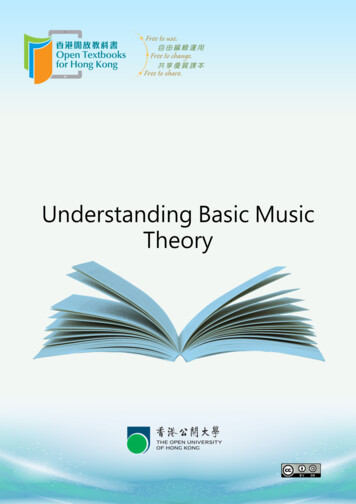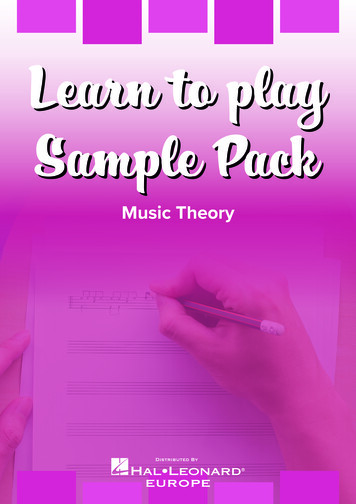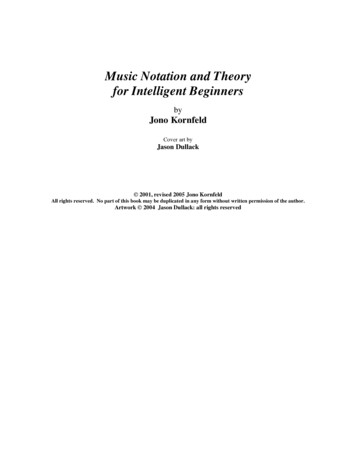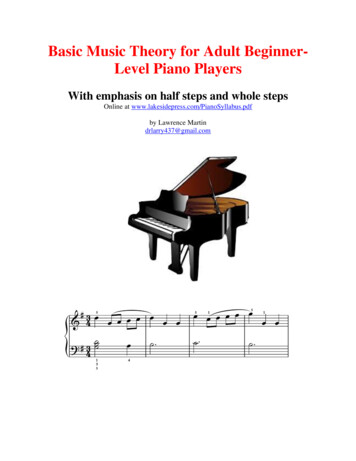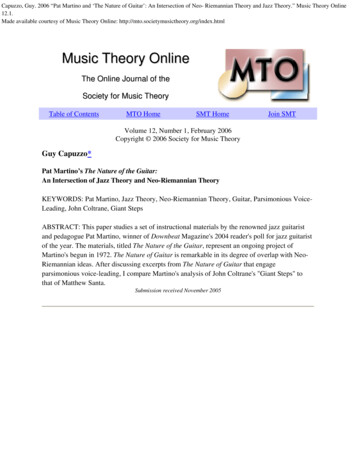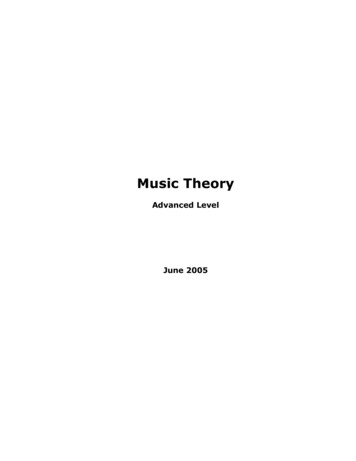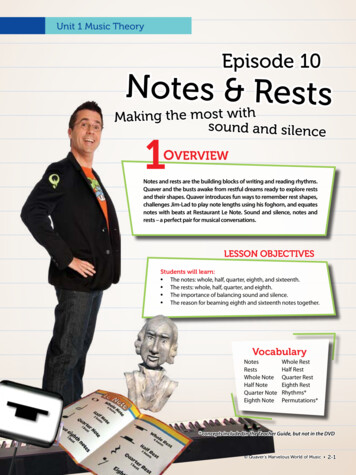
Transcription
Unit 1 Music TheoryEpisode 10Notes & RestsMaking the most withsound and silence1OVERVIEWNotes and rests are the building blocks of writing and reading rhythms.Quaver and the busts awake from restful dreams ready to explore restsand their shapes. Quaver introduces fun ways to remember rest shapes,challenges Jim-Lad to play note lengths using his foghorn, and equatesnotes with beats at Restaurant Le Note. Sound and silence, notes andrests – a perfect pair for musical conversations.LESSON OBJECTIVESStudents will learn: The notes: whole, half, quarter, eighth, and sixteenth. The rests: whole, half, quarter, and eighth. The importance of balancing sound and silence. The reason for beaming eighth and sixteenth notes together.VocabularyNotesRestsWhole NoteHalf NoteQuarter NoteEighth NoteWhole RestHalf RestQuarter RestEighth RestRhythms*Permutations** concepts included in the Teacher Guide, but not in the DVD Quaver’s Marvelous World of Music 2-1
Unit 1 Music TheoryMUSIC STANDARDS IN LESSON1: Singing alone and with others*5: Reading and notating music6: Analyzing and describing music8: Understanding the relationship between music and theother artsComplete details at QuaverMusic.comKey ScenesWhat they teachMusicStandard1Quaver dreams of rests.or doeshe?Rests or silences in music are as important as notes orsound. The four main types of rests are introduced.5, 62Rightly remembering restsRest placement and recognition are presented inmemorable ways.5, 63Jim-Lad and his foghorn.Argggh!Note lengths and their values are revisited withblaring results.5, 64Ordering at Restaurant Le NoteNotes and rests have a beat value which is critical toreading and writing music.5, 6, 85Song: When You’re a WholeNoteThis song employs a barbershop quartet to makenote and rest lengths memorable.5, 62LESSON INTRO Introducing the episodeRead a short passage from any book to the class without any gaps or breaths. Ask the studentswhy it sounds funny or strange. Ask a student to read like this as well.Then choose two students to converse without any pauses in between as the others watch. Thisis really hard to do, and quite funny. Point out when they stopped for breaths or paused.What is the reason for short silences when speaking? To breathe? Because the sentence or phrasehas ended? Or because there is something new to say?Sound and silence are used in music as well; they help the music to breathe. Music is combinations of notes and rests. Without silence, music would never end--which could be a good or badthing!2-2 QuaverMusic.com* concepts included in the Teacher Guide, but not in the DVD
Notes & Rests3Discussion Points What does a whole rest resemble?a hole in the groundWhat does a half rest resemble?a hatWhat does a quarter rest resemble?lightningWhat does an eighth rest resemble?a 7 with a wart on its nose4PRINTPRINTWORKSHEETWORKSHEETPLAY EPISODECLASS ACTIVITIESNotes and Rests CountdownWorksheet # 1IWB 1Purpose: Recognition of musical symbolsCut out the note flash-cards. Hold up the first one forten seconds; then ask students to name the symbol.Hold up the next card for nine seconds and so on until the time is reduced to one second! Keep a scoreof correct answers, then repeat the exercise. Try thisactivity on IWB equipped with a Quaver Timer.Rhythm ReplayIWB 2Purpose: Clapping rhythms and reading notationDirect students’ attention to the IWB where ten 4-beat rhythms are provided.The first rhythms are simple and grow progressively more difficult. Count outin a steady beat as students clap the rhythms. Press the play button to hearthe rhythm played correctly on the IWB.Note RacesPurpose: Exploring the relationship between beats, notes, and restsSet up two sets of four chairs in a row to represent a measure of 4 beats. Divide students into two teams. Show both teams a note value, then have themsafely race to their respective chairs to create that note using their bodies.The diagram below presents examples.Quarter noteRestQuarter noteNote: Empty chairs can represent quarter rests.2-3
Unit 1 Music TheoryGuess that NotePurpose: Listening and identifying rhythmsDivide students into two groups. Stand between the two groups and establish a steady beat in a 4/4 meterwith the first group. Then show a note value to the second group and have them clap out the value. Ask thesteady beat group to identify the note the other group is clapping. Students can make a very quiet or silent“Shhhhh” noise for the duration of rests instead of clapping. Switch the roles of the groups.VIDEO REPLAYIf You’re a Whole NoteTrack 1IWB 3Purpose: Singing together and learning notesWatch the video replay of If You’re a Whole Note (Track 1). Havestudents learn the song and count out the correct beat durations,especially the rests, as they sing. Notice the term whole note issung for four beats, half note is sung for two beats, and so on.Post note and rest symbols on a board or wall foreasy reference.5WEB ACTIVITIESQBackBeatQBackBeat provides a unique way ofdepicting notes and rests, allowingstudents to construct different percussion loops by clicking in the grid. Theycan save their rhythms to revisit lateror use their creations in a song.2-4 QuaverMusic.comQComposerStudents can make melodies usingdifferent note and rest durations.QComposer will also help them addchords to their compositions.IWBPlay activities on yourINTERACTIVE White Board
6Notes & RestsHOMEWORKClap a Rhythm, Make a RhythmWorksheet # 2Purpose: Clapping and creating rhythmsThis worksheet has 8 measures of 4 beats at varying levels of complexity. Demonstrate the exercise for students. Emphasize the importance of correctly depicting whole, half, quarter, and eighth notes andrests. Allow them to present their creations in the next session.PRINTPRINTWORKSHEETWORKSHEETRest ArtMaterialsNeeded- Colored pencilsWorksheet # 3Purpose: Recognition of musical symbolsBased on the animation in the show, students are provided with illustrations of the rests. They should use them in drawings to help themremember the rest symbols. (For example, the whole rest looks like ahole in the ground, but it could also be a cup, a boat, and so forth.)Additional session activities7ASSESSMENTPopsicle Stick DictationPRINTPRINTWORKSHEETWORKSHEETWorksheet # 4Give each student a set of 10-15 popsicle or craft sticks andthe worksheet. On the worksheet are the symbols for notesand rests which are to be pasted to the stick. Clap 4-beatrhythms and have students make the pattern using theirpopsicle notes and rests.MaterialsNeeded- Popsicle sticks- Scissors- Glue2-5
Unit 1 Music Theory8CROSS-CURRICULUM ACTIVITIESMathChallenge students to write down different combinations of 4-beat patterns using only quarter notes andquarter rests. Then have them try half notes and half rests. In math, these are called permutations. Themore types of notes or rests available, the more permutations can be created. See how many students cancreate!Social StudiesTrack 2In India, students learn to play a drum called the tabla and to vocalize special syllables for rhythms meantto sound like the drum. For example, Sounds of India (Track 2).Play a steady rhythm on a drum and challenge students to develop syllablesor words to go with the rhythm. Below are sample note/syllable combinations.Quarter notes: “WAP”Two eighth notes: “WAC-KA”Half notes: “WHOOSH”Example: “WAC-KA WAP WHOOSH”2-6 QuaverMusic.com
Notes & Rests9DIGGING DEEPERSweet 16thIWB 4Introduce students to music notes that are shorter than eighth notes. Using their knowledge of fractions,ask them to complete this progression: whole, half, quarter, eighth, , . (sixteenth,thirty-second)How many 16th notes would be clapped for one beat? 4How many 32nd notes would be clapped for one beat? 8Inquisitive InstrumentsInstruments play note durations in different ways. Take a whole note for example. A violinist plays a wholenote by keeping the bow smoothly moving across the string for 4 beats. How would a trumpeter play awhole note? (with his breath) A piano player? (by holding his finger on the note or by using the sustainpedal) A cymbal player? (allows the cymbal to ring until he stops it with his hand). Explore the techniquesused by the violin, trumpet, piano, and cymbal to produce half, quarter, eighth, and sixteenth notes. Havestudents mime the instrumental techniques involved.The Magic DotIWB 5Cut out some small black dots from the card and hide them around your room. Draw a whole note on theboard and ask students to tell you the value of that note (4 beats). Locate your magic dots! Stick one in frontof the whole note and tell students it has magically increased the duration of the note to 6 beats. Have students sing and hold the new duration. Do the same with the half note; the dot increases the value of the halfnote to 3 beats. Have them sing the new length. A dot in front of a quarter note increases it’s value to oneand a half beats, and placed in front of an eighth note it increases it to 3/4 of a beat. Ask students if they canwork out the relationship between the dot and the increase in duration.Q: What does the dot do?A: The dot increases the duration of the note by half its original value.Using the IWB sing the dotted rhythms presented.2-7
Unit 1 Music TheoryFeaturedInstrumentsPianoHandsVoiceDrum2-8 QuaverMusic.comTEACHER NOTES
Eighth Note Whole Rest Half Rest Quarter Rest Eighth Rest Rhythms* Permutations* sound and silence * concepts included in the Teacher Guide, but not in the DVD. Unit 1 Music Theory Read a short passage from any book to the class without any gaps or breaths. Ask the students why it sounds funny or strange. Ask a student to read like this as well. Then choose two students to converse without any .



